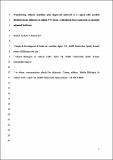Por favor, use este identificador para citar o enlazar a este item:
http://hdl.handle.net/10261/25693COMPARTIR / EXPORTAR:
 SHARE SHARE
 CORE
BASE CORE
BASE
|
|
| Visualizar otros formatos: MARC | Dublin Core | RDF | ORE | MODS | METS | DIDL | DATACITE | |

| Título: | Transferring Atlantic maritime pine improved material to a region with marked Mediterranean influence in inland NW Spain. A likelihood-based approach on spatially adjusted field data |
Autor: | Mata Pombo, Raúl de la; Zas Arregui, Rafael CSIC ORCID | Palabras clave: | Pinus pinaster Progeny trial Iterative spatial analysis Genotype x environment interactions Spatial autocorrelation REML estimation Genetic correlation Variance-covariance matrix Heterogeneous variance models |
Fecha de publicación: | jul-2010 | Editor: | Springer Nature | Citación: | European Journal of Forest Research, 129 (4): 645-658. | Resumen: | The inland region of Galicia (NW Spain) marks the boundary between the Atlantic climate of the coastal area and the typical Mediterranean climate of central Spain. Compared to the Atlantic coast, climate in this area has a pronounced summer drought, lower annual precipitation, and higher annual thermal oscillation. Despite the high productivity and ecological importance of maritime pine in inland Galicia, local forest reproductive material (FRM) of high genetic quality is not available for this area. Seed sources originating elsewhere and of unknown adaptation to this area are commonly used for reforestation. With the aim of finding new sources of FRM for this region and exploiting the genetic gains of existing breeding programmes, we analysed the performance in field conditions of improved families of the Coastal Galicia (CG) and Western Australia (WA) breeding programmes. Growth, stem characteristics and branch habit were evaluated in five progeny trials established following a coastal-to-inland gradient. Likelihood-based analyses were used to estimate genetic correlations between environments and to test statistically for causes and patterns of genotype x environment interaction. Because of the strong non-random spatial structures and heterogeneity of residual variances, the analyses were carried out using heterogeneous residual variance mixed models on spatially adjusted data. The results indicated that there is not sufficient evidence to subdivide Galicia into the two current deployment areas. Interaction patterns do not reveal significant differences between zones, and crossover interactions for height growth are present both between and within areas. On the inland sites, the Atlantic improved materials clearly outperformed unimproved seedlots tested in adjacent provenance trials, suggesting the feasibility of using both the CG and WA breeding materials as sources of FRM for reforestation in inland Galicia. Of the two, the WA material showed excellent results for all traits. The inclusion of this material into the Galician maritime pine breeding population should be strongly considered. | Versión del editor: | http://dx.doi.org/10.1007/s10342-010-0365-4 | URI: | http://hdl.handle.net/10261/25693 | DOI: | 10.1007/s10342-010-0365-4 | ISSN: | 1612-4669 |
| Aparece en las colecciones: | (MBG) Artículos |
Ficheros en este ítem:
| Fichero | Descripción | Tamaño | Formato | |
|---|---|---|---|---|
| Transferring_Atlantic...pdf | 306,03 kB | Adobe PDF |  Visualizar/Abrir |
CORE Recommender
SCOPUSTM
Citations
27
checked on 09-abr-2024
WEB OF SCIENCETM
Citations
27
checked on 20-feb-2024
Page view(s)
382
checked on 18-abr-2024
Download(s)
316
checked on 18-abr-2024
Google ScholarTM
Check
Altmetric
Altmetric
NOTA: Los ítems de Digital.CSIC están protegidos por copyright, con todos los derechos reservados, a menos que se indique lo contrario.
